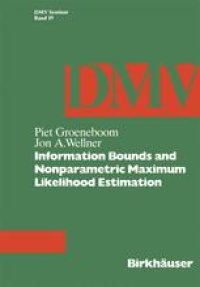
Ebook: Information Bounds and Nonparametric Maximum Likelihood Estimation
- Tags: Mathematics general
- Series: DMV Seminar 19
- Year: 1992
- Publisher: Birkhäuser Basel
- Edition: 1
- Language: English
- pdf
This book contains the lecture notes for a DMV course presented by the authors at Gunzburg, Germany, in September, 1990. In the course we sketched the theory of information bounds for non parametric and semiparametric models, and developed the theory of non parametric maximum likelihood estimation in several particular inverse problems: interval censoring and deconvolution models. Part I, based on Jon Wellner's lectures, gives a brief sketch of information lower bound theory: Hajek's convolution theorem and extensions, useful minimax bounds for parametric problems due to Ibragimov and Has'minskii, and a recent result characterizing differentiable functionals due to van der Vaart (1991). The differentiability theorem is illustrated with the examples of interval censoring and deconvolution (which are pursued from the estimation perspective in part II). The differentiability theorem gives a way of clearly distinguishing situations in which 1 2 the parameter of interest can be estimated at rate n / and situations in which this is not the case. However it says nothing about which rates to expect when the functional is not differentiable. Even the casual reader will notice that several models are introduced, but not pursued in any detail; many problems remain. Part II, based on Piet Groeneboom's lectures, focuses on non parametric maximum likelihood estimates (NPMLE's) for certain inverse problems. The first chapter deals with the interval censoring problem.
The book gives an account of recent developments in the theory of nonparametric and semiparametric estimation. The first part deals with information lower bounds and differentiable functionals. The second part focuses on nonparametric maximum likelihood estimators for interval censoring and deconvolution. The distribution theory of these estimators is developed and new algorithms for computing them are introduced. The models apply frequently in biostatistics and epidemiology and although they have been used as a data-analytic tool for a long time, their properties have been largely unknown. Contents: Part I. Information Bounds: 1. Models, scores, and tangent spaces • 2. Convolution and asymptotic minimax theorems • 3. Van der Vaart's Differentiability Theorem • PART II. Nonparametric Maximum Likelihood Estimation: 1. The interval censoring problem • 2. The deconvolution problem • 3. Algorithms • 4. Consistency • 5. Distribution theory • References
The book gives an account of recent developments in the theory of nonparametric and semiparametric estimation. The first part deals with information lower bounds and differentiable functionals. The second part focuses on nonparametric maximum likelihood estimators for interval censoring and deconvolution. The distribution theory of these estimators is developed and new algorithms for computing them are introduced. The models apply frequently in biostatistics and epidemiology and although they have been used as a data-analytic tool for a long time, their properties have been largely unknown. Contents: Part I. Information Bounds: 1. Models, scores, and tangent spaces • 2. Convolution and asymptotic minimax theorems • 3. Van der Vaart's Differentiability Theorem • PART II. Nonparametric Maximum Likelihood Estimation: 1. The interval censoring problem • 2. The deconvolution problem • 3. Algorithms • 4. Consistency • 5. Distribution theory • References
Content:
Front Matter....Pages i-viii
Front Matter....Pages 1-1
Models, Scores, and Tangent Spaces....Pages 3-12
Convolution and Asymptotic Minimax Theorems....Pages 13-21
Van der Vaart’s Differentiability Theorem....Pages 23-32
Front Matter....Pages 33-33
The Interval Censoring Problem....Pages 35-52
The Deconvolution Problem....Pages 53-63
Algorithms....Pages 65-74
Consistency....Pages 75-87
Distribution Theory....Pages 89-121
Back Matter....Pages 123-126
The book gives an account of recent developments in the theory of nonparametric and semiparametric estimation. The first part deals with information lower bounds and differentiable functionals. The second part focuses on nonparametric maximum likelihood estimators for interval censoring and deconvolution. The distribution theory of these estimators is developed and new algorithms for computing them are introduced. The models apply frequently in biostatistics and epidemiology and although they have been used as a data-analytic tool for a long time, their properties have been largely unknown. Contents: Part I. Information Bounds: 1. Models, scores, and tangent spaces • 2. Convolution and asymptotic minimax theorems • 3. Van der Vaart's Differentiability Theorem • PART II. Nonparametric Maximum Likelihood Estimation: 1. The interval censoring problem • 2. The deconvolution problem • 3. Algorithms • 4. Consistency • 5. Distribution theory • References
Content:
Front Matter....Pages i-viii
Front Matter....Pages 1-1
Models, Scores, and Tangent Spaces....Pages 3-12
Convolution and Asymptotic Minimax Theorems....Pages 13-21
Van der Vaart’s Differentiability Theorem....Pages 23-32
Front Matter....Pages 33-33
The Interval Censoring Problem....Pages 35-52
The Deconvolution Problem....Pages 53-63
Algorithms....Pages 65-74
Consistency....Pages 75-87
Distribution Theory....Pages 89-121
Back Matter....Pages 123-126
....